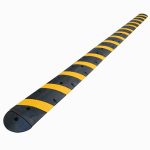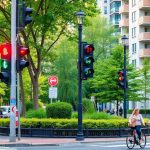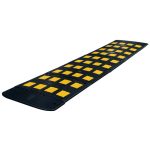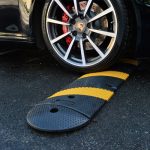In an era where urbanization is rapidly on the rise, traffic safety has become more critical than ever. As city streets become increasingly congested, the demand for effective traffic calming solutions grows. Among these solutions, one has emerged as both an environmental champion and a guardian of public safety: recycled rubber speed bumps.
The Eco-Friendly Guardian: Recycled Rubber Speed Bumps
A Sustainable Solution
It’s no secret that tires pose a significant environmental challenge. As they pile up in landfills, they become a fire hazard and a breeding ground for pests. However, when repurposed into speed bumps, these tires find new life on the roads they once traversed, this time serving to protect them.
Recycled rubber speed bumps are crafted from 100% recycled tire rubber. The process of transforming worn tires into speed bumps is not just an excellent example of upcycling but also significantly reduces the ecological footprint associated with traffic safety equipment production.
Unyielding in Safety, Yielding to Nature
The beauty of these rubber speed bumps lies in their durability and flexibility. Unlike their concrete counterparts, rubber speed bumps can withstand severe weather conditions without cracking. Their pliable nature allows them to contour to the surface they’re installed on, ensuring they maintain maximum effectiveness and minimize wear on vehicles.
Moreover, their shock-absorbent property significantly reduces the amount of noise generated when vehicles pass over them, contributing to a quieter, more peaceful community environment.
The Science of Visibility: Cat Eye Reflectors and Reflecting Yellow Ribbons
Enhancing Night Vision with Innovation
A critical component of traffic safety equipment is visibility, particularly during nighttime and in adverse weather conditions. Recycled rubber speed bumps are often embedded with ‘cat eye’ reflectors, which serve as a guiding light for drivers. The term ‘cat eye’ comes from the technology’s ability to mimic the glowing eyes of a cat, a natural phenomenon that captures and reflects even the faintest light.
These reflectors are strategically placed to optimize visibility, ensuring that the speed bumps are detectable from a distance, allowing drivers ample time to slow down.
The Reflecting Yellow Ribbon: A Bright Reminder
Accompanying the cat eye reflectors is the reflecting yellow ribbon. This feature stands out during both day and night, serving as a vivid caution sign. The contrast of the bright yellow against the black rubber makes the speed bump visible from afar, reducing the risk of sudden braking and collisions.
An Ingenious Design: Canals for Drainage and Utility Passage
The Bottom Canals: An Ingenious Addition
One ingenious feature of these rubber speed bumps is the inclusion of bottom canals. These canals serve a dual purpose:
- Drainage: By facilitating the flow of rainwater, these canals prevent water from pooling around the speed bumps. This feature is crucial in maintaining road safety during wet conditions and in preventing damage to the road surface.
- Utility Lines: The canals also offer a channel for wiring or street pipes, allowing for utilities to be laid without the need to disrupt the road surface. This innovation not only reduces installation costs but also minimizes the inconvenience to traffic during maintenance work.
The Benefits of Choosing Recycled Rubber Speed Bumps
Safety Meets Sustainability
The installation of recycled rubber speed bumps offers a host of advantages. They provide a high-traction surface which ensures vehicles can slow down safely, even in wet conditions. Their recycled nature makes them a cost-effective and environmentally friendly option, reducing the demand for new raw materials and repurposing existing waste products.
Longevity and Ease of Installation
These speed bumps are not only long-lasting but also relatively easy to install. Their modular design allows for a quick setup and removal if necessary, providing flexibility to city planners and traffic authorities. The ease of installation means less downtime for roads, which is critical in busy urban environments.
Low Maintenance, High Performance
The durability of recycled rubber means these speed bumps require minimal maintenance. They resist chipping, warping, and erosion — common issues with traditional materials. The reduced need for replacements means fewer resources are consumed over the lifespan of the speed bump, and less waste is generated.
Conclusion: A Step Forward in Traffic Safety and Sustainability
As cities continue to grapple with the twin challenges of traffic safety and environmental sustainability, recycled rubber speed bumps offer a beacon of hope. Their innovative design, which incorporates visibility-enhancing features and utility-friendly canals, sets a new standard in the field of traffic safety equipment.
The shift towards these eco-conscious alternatives is more than a trend; it’s a sustainable choice that benefits not just the current urban landscape but future generations. By choosing recycled rubber speed bumps, communities are not just slowing down vehicles; they’re advancing towards a greener, safer future for everyone on the road.
This choice represents a broader commitment to innovative solutions that address modern challenges without compromising on our ecological responsibilities. As we continue on the journey to safer streets and a cleaner planet, the recycled rubber speed bump stands out as a symbol of progress — a small yet significant piece of the





